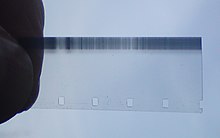Tone negative
In film production, the tone negative is, in addition to the image negative, the strip from which positives are “drawn” (copied) when a film is being reproduced . This is done on copier machines with an image and a sound copier head, on which the negatives are combined with the raw film .
The barrel negative has the same dimensions as the picture negative. During the transition from silent film to sound film , it was determined that the picture ( normal picture ) would be made 10 percent narrower and that the sound would take place in the space that was freed up.
Traditionally, the sound of an event was recorded on normal film as a 1/10 inch wide sound track parallel to the image recording with a so-called sound camera . With synchronous motors in the same electricity network, the devices were forced to run in sync .
When the photographic sound recording was replaced by the magnetic one from around 1948, the sound negative slipped out of the field of vision of production and into distribution. Today it is generated from the finished sound mixture, but the available frequency and dynamic ranges must be taken into account. The cost of producing sound negatives is only worthwhile for mass copies for projection purposes.
Basically there are sound negatives in every film format, although the 70 mm format has not become established. Optical sound is also possible on 8 mm film, but the sound quality is quite limited. For 16 mm optical sound copies of the 35 mm source material, however, a new audio negative is usually not made for cost reasons, but the reduced 35 mm audio negative is then copied twice next to one another so that the audio track still has the necessary dynamics and sufficient signal-to-noise ratio through the reduction Has.
Recording method
A distinction is made between three fundamentally different methods of exposing motion picture film for analog sound recording, the intensity method with the result of a spur script, the transversal method with the result of serrated scripts and the longitudinal method . The latter also causes sprouts, but is practically not in use due to optical difficulties.
Sprout script tone negatives must be produced with little photographic contrast. Zigzag tone negatives are developed for the greatest possible contrast. In any case, the tone negative must be copied continuously. However, this can happen very quickly. In order to be able to perfectly duplicate older tone negatives, so-called slip-free tone copying machines were designed as early as the 1930s, with which one wanted to take account of excessively shrunk tone negatives. But it has been shown that there is a limit at which new (optical) errors creep in.
Analog and digital
The classic tone negative has been joined by the numerically digital, which is also finest grain black and white film. Analog and digital audio tracks can also be placed on a single audio negative.
Raw film for tone negatives
The pioneers used positive film because it had the finest graininess at the time. In 1929 Agfa brought the first specially made film material onto the market, which was simply called sound film. Eastman-Kodak did not follow suit until 1933.
Today, 2010, these raw films are available:
- Agfa-Gevaert S (ound) T (rack) 8 D (igital) and ST 9
- Eastman EXR Sound Recording Film -378 E, Kodak Panchromatic Sound Recording Film -374 E
- Orwo T (on-) F (ilm) 12 d (igital)
